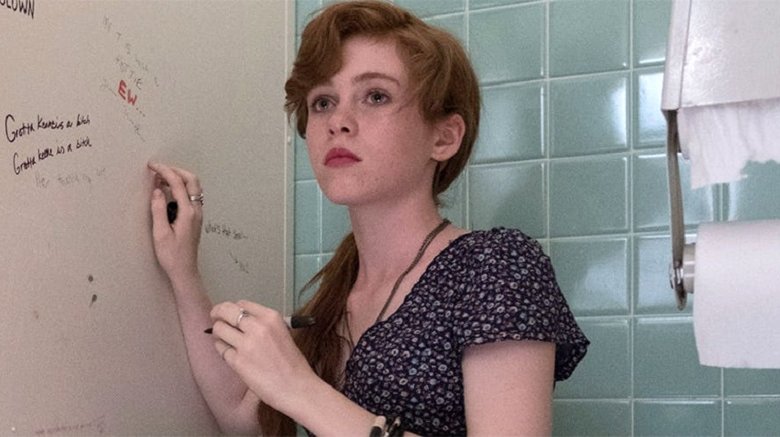The It: Chapter One Post-Credits Scene You Didn't Get To See
It: Chapter One almost had a couple more pages.
In a wide-ranging interview with Huffington Post, director Andy Muschietti revealed that the smash hit 2017 film was to include a post-credits sequence — one that would have introduced audiences to one of the adult cast of It: Chapter Two.
The interview gives us a fascinating inside look at an ambitious project: adapting Stephen King's masterful 1986 novel It, which clocks in at over 1,100 pages and follows its protagonists both as children and adults, into a one-two cinematic punch. The novel and films tell the story of a group of outcast youngsters who dub themselves the Losers' Club, who must do battle with an ancient, malevolent, shape-shifting entity which appears most often in the guise of Pennywise, the Dancing Clown, and which awakens every 27 years to wreak havoc on their sleepy small town of Derry, Maine. During a battle in the sewers beneath the town's streets, the children seriously wound It and drive It back into hibernation — but they fail to seal the deal, and when It awakens over a quarter-century later, they return to Derry to finish what they started.
While the novel jumps back and forth between the two time periods in which it takes place, Muschietti and screenwriter Gary Dauberman chose to forgo that route in favor of tackling the earlier time period in the first film, and the later period in the second.
While It: Chapter One's young cast will appear via flashbacks in the second chapter (which presented difficulties of its own), none of the adult cast of It: Chapter Two made appearances in Chapter One. This, however, was very nearly not the case: Muschietti related that the original plan was to include a post-credits sequence which would have featured the grown-up version of Beverly Marsh, who is portrayed by Sophia Lillis as a child and Jessica Chastain as an adult.
"Something a lot of people probably don't know is [that] Chapter One did have the idea to make a post-credit scene, which was Beverly Marsh picking up the phone," Muschietti explained. "So, 27 years later, post-credit, you would see a phone ringing. It's an iPhone, so it's impossible that it's 1989, and a hand comes in and the camera wraps around this red-haired back of a head, and we turn around, and it's Jessica Chastain!"
The tidbit reveals just how early in the process of It: Chapter Two's production that the filmmakers had pegged Chastain as their choice for the adult Beverly. Unfortunately, scheduling conflicts prevented the post-credits scene from being shot — but Chastain eventually agreed to take on the role anyway, to the delight of the filmmakers.
Mid- or post-credits sequences have become ubiquitous in franchise pictures, and for that, you can thank Mighty Marvel Studios. Marvel certainly wasn't the first to do it, but the post-credits scene likely never would have become a pop culture staple if not for 2008's Iron Man. After that flick's credits rolled, audiences were introduced to Samuel L. Jackson's Nick Fury, who appeared to recruit Tony Stark into the "Avenger Initiative," and make plain the interconnected nature of the movies that would follow.
Post-credits sequences have been a part of every Marvel Cinematic Universe feature since (with the exception of Avengers: Endgame), and franchises from the rival Worlds of DC to Legendary's MonsterVerse to the Fast and Furious flicks have followed suit. While it may seem a little superfluous, the scene Muschietti described would have been a fantastic lead-in to It: Chapter Two — and also would have served to tease the spot-on quality of the flick's casting, as the production somehow managed to land actors who are eerily similar to their young counterparts, across the board.
Oddly enough, the appearance of the younger cast in It: Chapter Two forced Muschietti to take another page from the Marvel playbook: digital de-aging. Marvel has often used the technique to depict younger versions of older characters, but as Muschietti explained, he found himself employing it to make kids appear as if they were even younger kids — a situation which the director seemed to have no trouble seeing the absurdity of.
"Of all the things, we had to de-age the kids," he said. "We shot the first part in 2016, and these kids were 12 and 13 years old. They're at the age where a week difference makes their voice drop, they hit puberty, suddenly their nose sticks out and they have a mustache. So three years later, we reunite with them and they had grown, some more than others. De-aging was on the table very, very early on in the talks."
Just because the director had his post-credit hopes for the first flick dashed, though, doesn't mean he's keen to revisit the idea for the second. There's a pretty simple reason for that: there's nothing to tease.
"Post-credit scenes a la Marvel normally have a very distinct function, which is [to] tease people about a future movie," the director said. "But yeah, this is, like, the idea that this is over."
We can safely take this to mean there won't be an It: Chapter Three, which would have to expand on the story told in King's novel. Money talks, however — and since It: Chapter One is the highest-grossing horror film of all time, and its sequel looks likely to supplant it, a third movie isn't outside the realm of possibility. Muschietti even coyly alluded to this when asked if It: Chapter Two definitively concludes the story.
"For now," he said. And somewhere, down in the sewers beneath Derry, a clown laughs.
